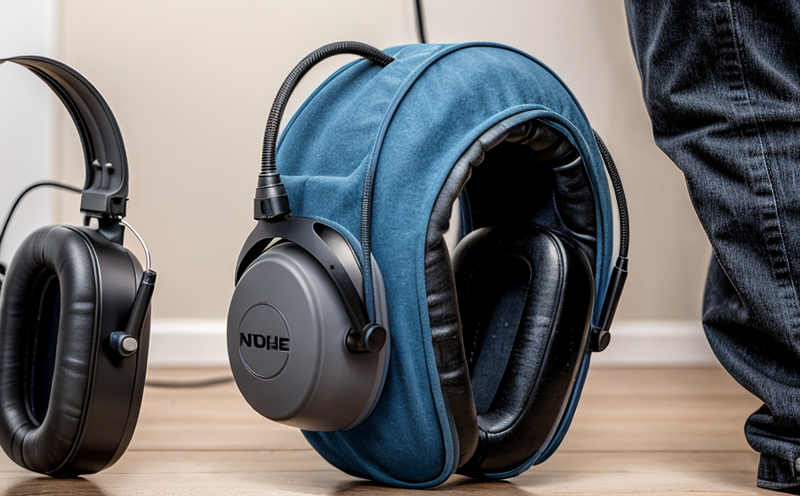ASTM E1414 Airborne Sound Insulation Testing
ASTM E1414 is a critical standard used to determine the airborne sound insulation performance of partitions, walls, and floors. This testing is essential for ensuring that buildings meet noise reduction requirements set by various standards and regulations. Compliance with these standards ensures occupant comfort, privacy, and overall acoustic quality within the workspace or home environment.
The ASTM E1414 test evaluates how effectively a partition blocks sound from one room to another under controlled conditions. The standard specifies the procedures for measuring airborne noise transmission through partitions in buildings. This includes both single and multi-story buildings, as well as various types of walls, floors, and ceilings used as partitions.
The primary purpose of ASTM E1414 testing is to quantify the sound insulation performance of a partition using a standardized method that can be consistently reproduced across different locations and laboratories. The test measures the sound power level difference between two rooms separated by the partition under controlled conditions. This allows for an accurate comparison of partitions' acoustic properties.
For effective implementation, the specimen must be prepared according to ASTM E1414 guidelines. Typically, this involves mounting the partition in a specially designed reverberation room where it is exposed to known sound sources on one side and an appropriate receiver (microphone) on the other side. The test setup ensures that any reflections from the room surfaces are minimal.
The instrumentation used for ASTM E1414 testing includes high-quality microphones, signal generators, and data acquisition systems capable of capturing precise measurements over a wide frequency range. The standard specifies the use of octave band filters to break down the sound spectrum into manageable segments for analysis. This ensures that all relevant frequencies contributing to noise transmission are captured accurately.
The acceptance criteria for ASTM E1414 testing define acceptable levels of sound insulation performance based on the partition's intended use and location within the building. For example, partitions in residential areas may have stricter requirements than those in industrial settings due to differences in expected noise environments. Compliance with these criteria ensures that newly constructed or renovated buildings meet local regulations and provide a comfortable acoustic environment for occupants.
Understanding ASTM E1414's application is crucial for ensuring accurate testing results. Factors such as proper setup, calibration of equipment, and adherence to procedural steps play significant roles in obtaining reliable data. Non-compliance with these requirements can lead to inaccurate measurements or invalid test results, which could affect the integrity of a building's acoustic design.
ASTM E1414 testing is widely used by quality managers, compliance officers, R&D engineers, and procurement professionals involved in facility design and construction projects. It provides valuable insights into potential issues related to noise pollution and helps identify areas for improvement early in the project lifecycle. By incorporating ASTM E1414 into their processes, organizations can ensure they meet regulatory requirements while enhancing occupant satisfaction through better acoustic performance.
Implementing ASTM E1414 testing ensures that partitions installed in buildings effectively block sound transmission between rooms or spaces, contributing to a more comfortable and productive work environment. This aligns with broader goals of sustainable building practices by promoting energy efficiency and reducing environmental impact through improved design.
Customer Impact and Satisfaction
- Enhanced Acoustic Comfort: Ensuring compliance with ASTM E1414 helps create quieter environments, reducing noise disturbances in shared spaces.
- Promotes Occupant Health & Well-being: Effective sound insulation contributes to better sleep quality and reduces stress levels among occupants.
Implementing ASTM E1414 testing demonstrates a commitment to providing high-quality acoustic environments, leading to increased customer satisfaction and loyalty. By adhering to this standard, organizations can ensure they meet regulatory requirements while enhancing the overall experience for those using or working in their facilities.
Competitive Advantage and Market Impact
- Regulatory Compliance: Demonstrating adherence to ASTM E1414 shows that an organization prioritizes safety, health, and comfort for its customers or employees. This can be a significant selling point in competitive markets.
- Innovation & Quality Reputation: Investing in ASTM E1414 testing fosters innovation by identifying opportunities to improve acoustic performance beyond basic compliance levels. A strong reputation for quality enhances brand image and attracts more clients.
By prioritizing ASTM E1414 testing, organizations can differentiate themselves from competitors who may not adhere strictly to industry standards. This commitment translates into long-term benefits, including improved customer relationships and increased market share.
Use Cases and Application Examples
The application of ASTM E1414 extends beyond new constructions; it is also beneficial for existing buildings undergoing renovations or modifications aimed at improving acoustic performance. In such cases, testing helps identify areas requiring attention and provides a baseline against which improvements can be measured.
For instance, in commercial settings like offices or retail spaces, effective sound insulation ensures that conversations remain private while still allowing natural light to enter through windows without excessive noise intrusion. Similarly, in healthcare facilities, maintaining privacy during consultations is paramount, making ASTM E1414 testing invaluable for ensuring compliance with strict regulations.
Residential properties benefit greatly from ASTM E1414 as well. For example, apartment buildings can significantly reduce tenant complaints about noisy neighbors by implementing partitions that meet the specified sound insulation criteria. Schools and universities also find this standard useful in creating calm learning environments free from disruptive noises.





